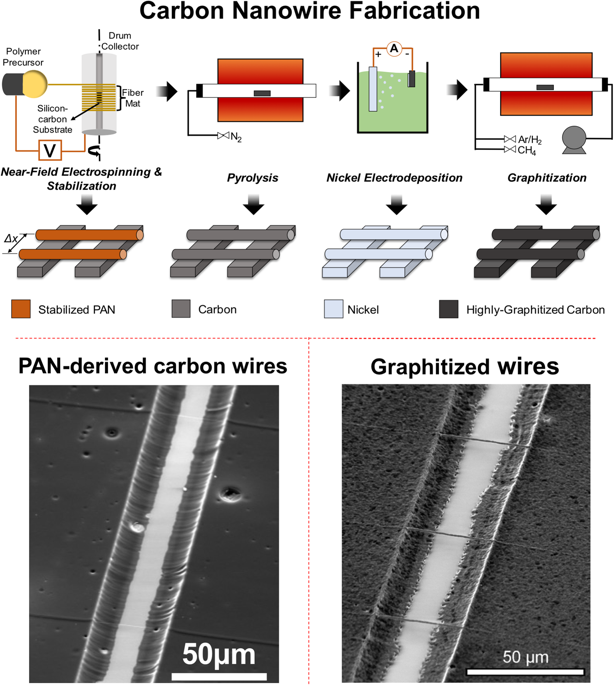Microsystems & Nanoengineering ( IF 7.3 ) Pub Date : 2020-01-13 , DOI: 10.1038/s41378-019-0117-7 Derosh George 1 , Adrian Garcia 2 , Quang Pham 3 , Mario Ramos Perez 4, 5 , Jufeng Deng 1, 6 , Michelle Trang Nguyen 2 , Tuo Zhou 3 , Sergio O Martinez-Chapa 4 , Yoonjin Won 1, 3 , Chong Liu 6 , Roger C Lo 7 , Regina Ragan 2 , Marc Madou 1

|
We herein report a high-resolution nanopatterning method using low voltage electromechanical spinning with a rotating collector to obtain aligned graphitized micro and nanowires for carbon nanomanufacturing. A small wire diameter and a small inter-wire spacing were obtained by controlling the electric field, the spinneret-to-collector distance, the pyrolysis parameters, the linear speed of the spinneret, the rotational speed of the collector. Using a simple scaling analysis, we show how the straightness and the diameter of the wires can be controlled by the electric field and the distance of the spinneret to the collector. A small inter-wire spacing, as predicted by a simple model, was achieved by simultaneously controlling the linear speed of the spinneret and the rotational speed of the collector. Rapid drying of the polymer nanowires enabled the facile fabrication of suspended wires over various structures. Patterned polyacrylonitrile wires were carbonized using standard stabilization and pyrolysis to obtain carbon nanowires. Suspended carbon nanowires with a diameter of <50 nm were obtained. We also established a method for making patterned, highly graphitized structures by using the aforementioned carbon wire structures as a template for chemical vapor deposition of graphite. This patterning technique offers high throughput for nano writing, which outperforms other existing nanopatterning techniques, making it a potential candidate for large-scale carbon nanomanufacturing.
中文翻译:

使用低压近场静电纺丝、热解、电沉积和化学气相沉积制造图案化石墨化碳线
我们在此报告了一种高分辨率纳米图案化方法,该方法使用带有旋转收集器的低压机电纺丝来获得用于碳纳米制造的对齐石墨化微米和纳米线。通过控制电场、喷丝头到收集器的距离、热解参数、喷丝头的线速度、收集器的旋转速度,获得小线径和小线间距。使用简单的缩放分析,我们展示了如何通过电场和喷丝头到收集器的距离来控制线的直线度和直径。通过同时控制喷丝头的线速度和收集器的旋转速度,实现了由简单模型预测的较小的线间距。聚合物纳米线的快速干燥使得能够在各种结构上轻松制造悬浮线。使用标准稳定化和热解将图案化的聚丙烯腈线碳化以获得碳纳米线。获得直径<50 nm的悬浮碳纳米线。我们还建立了一种通过使用上述碳线结构作为石墨化学气相沉积模板来制造图案化、高度石墨化结构的方法。这种图案化技术为纳米写入提供了高通量,优于其他现有的纳米图案化技术,使其成为大规模碳纳米制造的潜在候选者。使用标准稳定化和热解将图案化的聚丙烯腈线碳化以获得碳纳米线。获得直径<50 nm的悬浮碳纳米线。我们还建立了一种通过使用上述碳线结构作为石墨化学气相沉积模板来制造图案化、高度石墨化结构的方法。这种图案化技术为纳米写入提供了高通量,优于其他现有的纳米图案化技术,使其成为大规模碳纳米制造的潜在候选者。使用标准稳定化和热解将图案化的聚丙烯腈线碳化以获得碳纳米线。获得直径<50 nm的悬浮碳纳米线。我们还建立了一种通过使用上述碳线结构作为石墨化学气相沉积模板来制造图案化、高度石墨化结构的方法。这种图案化技术为纳米写入提供了高通量,优于其他现有的纳米图案化技术,使其成为大规模碳纳米制造的潜在候选者。通过使用上述碳线结构作为石墨化学气相沉积模板的高度石墨化结构。这种图案化技术为纳米写入提供了高通量,优于其他现有的纳米图案化技术,使其成为大规模碳纳米制造的潜在候选者。通过使用上述碳线结构作为石墨化学气相沉积模板的高度石墨化结构。这种图案化技术为纳米写入提供了高通量,优于其他现有的纳米图案化技术,使其成为大规模碳纳米制造的潜在候选者。











































 京公网安备 11010802027423号
京公网安备 11010802027423号